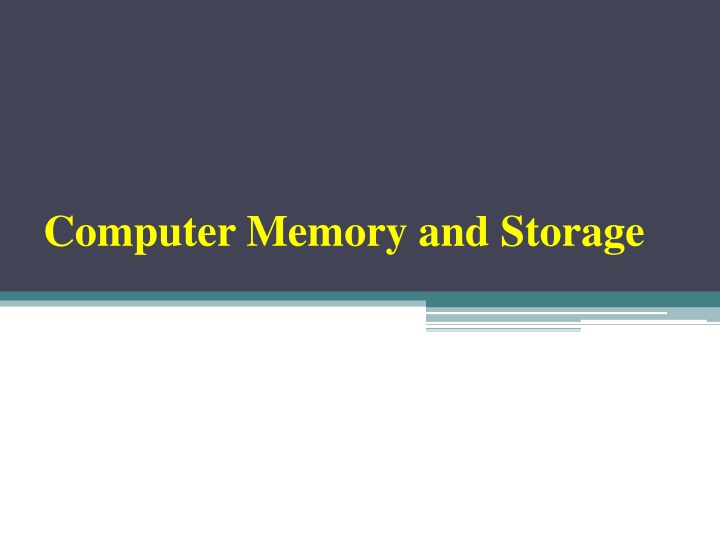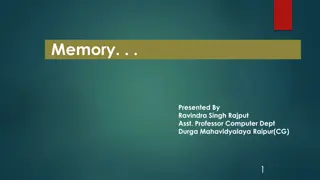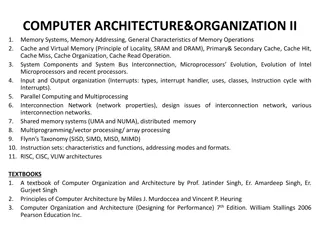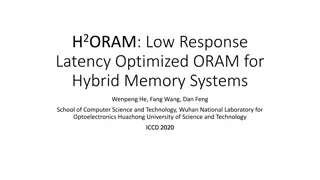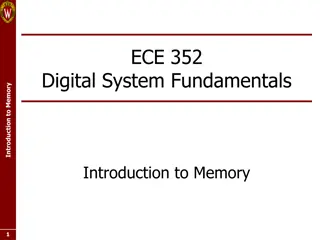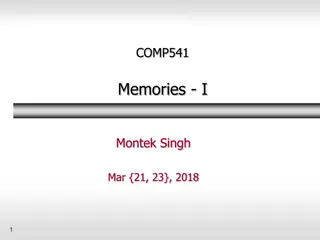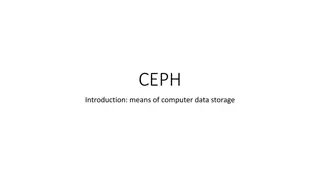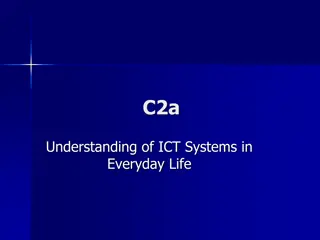Computer Memory and Storage
Computer memory and storage are fundamental components of digital systems. They involve the use of binary digits to represent data, with units such as bits, bytes, kilobytes, megabytes, gigabytes, and terabytes. The memory hierarchy includes internal processor memory, primary memory (RAM and ROM), and secondary memory. RAM provides direct access to the processor but is volatile, while ROM stores essential data and is non-volatile. Understanding these concepts is crucial for comprehending computer operation and data storage.
Download Presentation

Please find below an Image/Link to download the presentation.
The content on the website is provided AS IS for your information and personal use only. It may not be sold, licensed, or shared on other websites without obtaining consent from the author.If you encounter any issues during the download, it is possible that the publisher has removed the file from their server.
You are allowed to download the files provided on this website for personal or commercial use, subject to the condition that they are used lawfully. All files are the property of their respective owners.
The content on the website is provided AS IS for your information and personal use only. It may not be sold, licensed, or shared on other websites without obtaining consent from the author.
E N D
Presentation Transcript
Computer Memory and Storage Introduction All quantities measured in terms of UNITS. Digital computers works with two states, that represented voltages within the circuits. ON OFF For Examples: 0 Volts False Value +5 Volts True Value Each of these values represented either 0 or 1- BINARY DIGIT or BIT. Smallest unit of data that the computer can use.
Computer Memory and Storage Units used to measure Computer Memory Sl. No. 1. Units Description Bit A binary digit is logical 0 and 1 . Represented by lower case-b 2. Byte A group of 8 bits is called byte. Contains binary number between 00000000 and1111111. Represented by lower case-B 1 KB = 1024 Bytes In Decimal-1000, but in Computer memory-1024. Represented by lower case-KB 1 MB = 1024 KB Represented by lower case-MB 1 GB = 1024 MB Represented by lower case-GB 1 TB = 1024 GB Represented by lower case-TB 3. Kilo Byte 4. Mega Byte 5. Giga Byte 6. Tera Byte
Computer Memory and Storage Memory Hierarchy Three fundamental types of memory. Internal Processor Memory Primary Memory Secondary Memory
Computer Memory and Storage Internal Processor Memory (Processor Memory) It is placed within the CPU or it is attached to a special type of bus. It includes cache memory and special registers. This memory is used for temporary storage of data and instructions. Fastest among all the memories. Therefore diminutive part of the internal memory used in the computer system. It is unusually used to compensate the speed gap between the primary memory and the processor.
Computer Memory and Storage Primary Memory (Main Memory) Two Category RAM Random Access Memory ROM Read Only Memeory
RAM- Random Access Memory Provides direct information to processor. It is Volatile in nature. When the computer turned OFF, RAM clean all its memory. It can be defined as a block of sequential memory locations. The data and the instructions can be accessed one by one.
ROM- Read Only Memory. It stores the initial back up and Basic Input / Output System (BIOS). It is Non-Volatile in nature. The instructions in the RAM are built-in FIRMWRE. It access the data and instructions Randomly.
Computer Memory and Storage Secondary Memory It also known as Auxiliary Memory. It provides backup for data and instructions. Examples- Magnetic disk and Magnetic Tape. Less expensive, large storage capacity. Permanent storage devices. It can also be used as Overflow Memory(virtual Memory)
Computer Memory and Storage Memory Hierarchy
RAM- Random Access Memory It is like computer scratch card. It allows to store immediate calculation data and results of computation. It can perform both the read and write function. It is Volatile in nature. When the computer turned OFF, RAM clean all its memory.
Types of RAM SRAM Static Random Access Memory Stable Volatile DRAM Dynamic Random Access Memory Unstable Non Volatile It doesn't need periodic refreshing to preserve the information. It need continually refreshing to preserve the information. Used as a Cache Memory. Used as a Main memory. Data access is faster. Stores the data till power is supplied. Data access is slower. Stores the data only for few milliseconds even when power is supplied. Consumes less power Consumes more power. Expensive Inexpensive
Computer Memory and Storage ROM - Read-only memory It can only read the data which in stored in it. This is special chip, where start up instructions are stored. It contains BIOS of system. This is non-volatile in nature. It performs only read function not write function. So the data stored in ROM cannot be modified. Once the ROM chip are programmed, it cannot be re- written. ROM data and instructions written into it only one time. Some instructions in the ROM chip cannot be changed. ROM chips not only in the computer but also used in electronic items like washing machines and microwaves.
Computer Memory and Storage Types of ROM Masked ROM PROM EPROM EEPROM Flash ROM
Computer Memory and Storage Masked ROM The very first ROM-masked ROM. Contents are specified before the chip production. These were hard-wired devices that contained a pre-programmed set of data or instructions. It is inexpensive ROM.
Computer Memory and Storage PROM- Programmable Read Only memory The user buys a blank PROM and enters the desired contents using a PROM programmer. PROM is read-only memory that can be modified only once by a user. Hence PROM chips are known as One-Time Programmable(OTP) device. It is Non-Volatile in nature. Data stored permanently. Manufactured as blank memory. Therefore it is economical.
Computer Memory and Storage EPROM - Erasable Programmable Read Only Memory Known as ErasablePROM . The word erasable means we can change or erase the data. It can be erased and reprogrammed repeatedly. EPROM can be erased by exposing it to ultra-violet light for a duration of certain amount of time. Note- EPROM eraser is non selective(erase entire EPROM). Expensive.
Computer Memory and Storage EEPROM- Electrically Erasable Programmable Read-only Memory This type of ROM which can be erased by electrical charges. Written to by using slightly higher than normal voltages. EEPROM can be erased one byte at anytime rather than erasing the entire chip by ultra violet rays. Hence, the process of reprogramming is flexible but slow.
Computer Memory and Storage Flash ROM Flash memory (flash) is a modern type of EEPROM. Flash memory can be erased and rewritten faster than ordinary EEPROM but it erased in the manner of BIT by BIT. Examples: CD-ROM
